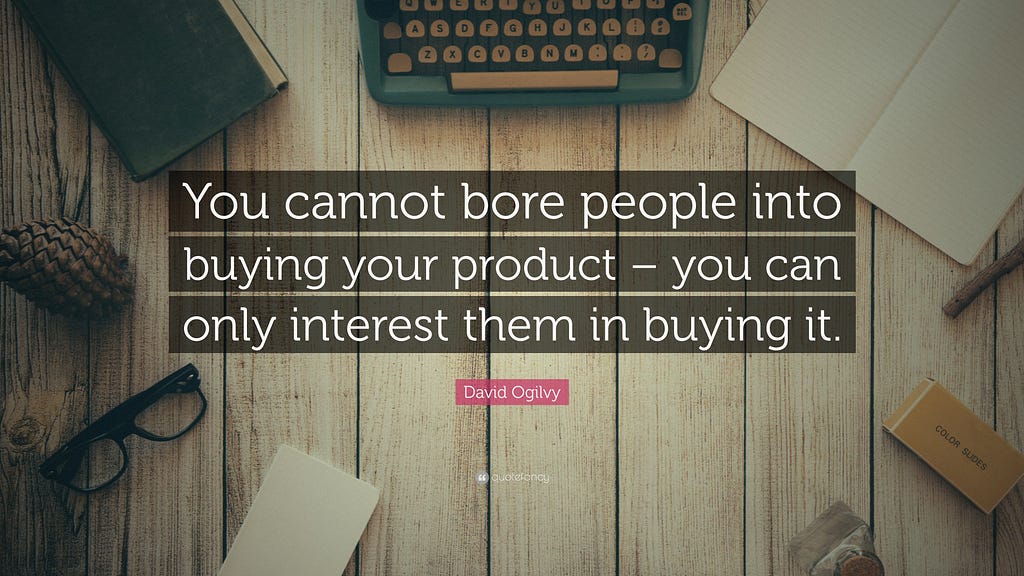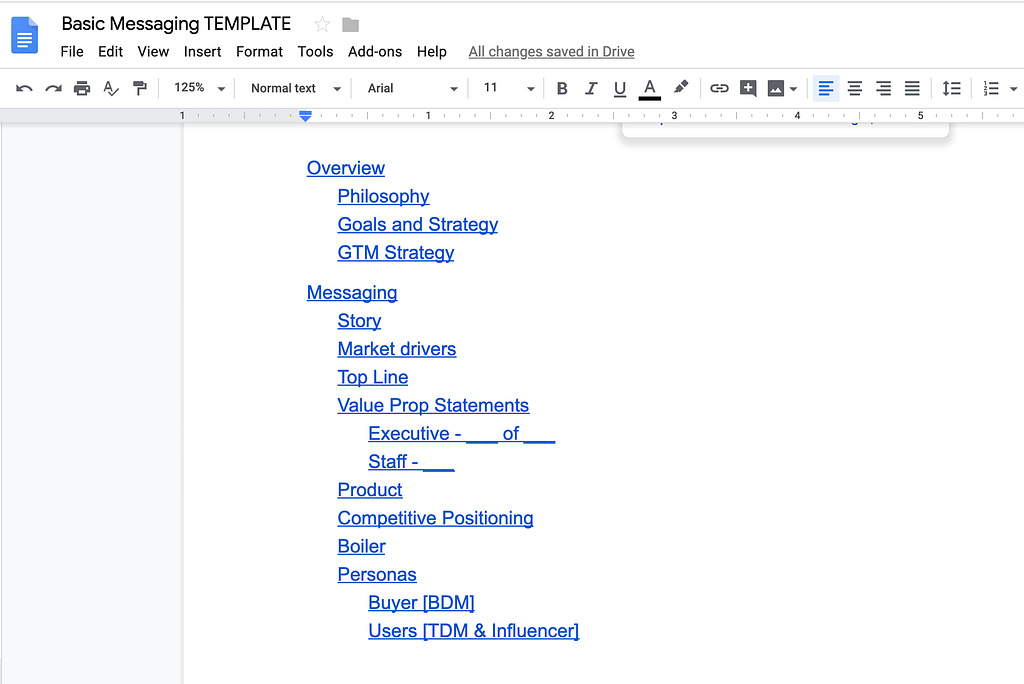Latest news about Bitcoin and all cryptocurrencies. Your daily crypto news habit.
Marketing 201 for Engineers: Messaging & Positioning
How to develop and test your story Found on QuoteFancy
Found on QuoteFancy
From Marketing 101 for Engineers: A Functional Introduction…
Product Marketing is a wide set of disciplines. Roughly speaking, it’s a mid-funnel activity — though depending on the company, it reaches all the way to the top (running campaigns and leading demand gen activities) and all the way to the bottom (acting as sales engineering) of the funnel. Sometimes it takes over many activities that are typically considered brand, communications, and even product management.
But you can put all of those things into three broad categories:
- Storytelling — Messaging and Positioning
- Launching — Go To Market
- Closing — Sales Enablement
In this post, we’ll focus on the first.
Programming notes: this post is in a series of indeterminate length on GTM topics mainly for startup people, mainly leadership, mainly coming from non-GTM backgrounds. There’s a list at the end.
The Story
Telling your story is the first job of marketing, and product marketing specifically. Your story as a company, as well as the story of your product(s). At early stage startups, these are often so tightly interwoven as to be the same thing.
This story needs the same components as any other story: a plot with a central conflict, protagonists and antagonists, and some resolution to that conflict.*
- What was wrong in the world that you saw?
- Who or what caused that?
- How are you going to fix it?
- What will the world be like after you’ve fixed it?
In other words:
- What did you build?
- Why did you build it?
- Who did you build it for?
- Why should they use it?
- Why should they pay for it?
- How is their life going to be different?
- How does it compare to every other way they could do that?
- How do the specific features and capabilities of the product specifically make all those things true?
There should be a core, overarching story which answers these questions. In turn, this story feeds smaller, derivative stories that come and go over the life of a product or company. The core story is our “messaging platform.” The derivative stories are versions put to use in different venues, for different audiences, or as reflective of something very specific like for a particular feature.
In the beginning, everything is being constantly refined as we hone in on the best way to talk about what we’ve built, usually for two primary audiences: investors to convince them to give us money and customers to convince them to.. give us money.
Over time, the core story will change infrequently, while the derivative stories can be quite disposable. At that point, when the core story changes, it’s a signal company is going through a significant product or go to market transition, maybe pivoting.
Advice
You have to speak in the language of the people you want to market to. Trying to get people to understand you when you’re speaking in jargon they don’t know or inventing words they’ve never heard is hard. Creating categories is hard. You can do it, but be prepared to not win for a very long time before it takes.
*Yes, not all stories work like this. Ack.
Messaging vs Positioning
Messaging is your story.
Positioning is how your product and company fit in to the (competitive) marketplace — how you are different from, and the same as, everyone else.
Positioning is way more important than messaging when it comes to selling.
Position against BI tools? Then you will be feature-compared to BI tools, price-compared to BI tools, be subject to expectations in prospects’ minds created by their experience and knowledge of BI tools. [This is the point at which many startup founders will start nodding their heads and groaning.]
Positioning, however, is not entirely in your hands. No matter how hard you try to position as X, if customers and analysts and press put you in bucket Y.. you’re in bucket Y.
The Process
The process of developing messaging and positioning can be painful, mainly because people can’t come to a consensus on something that they can support but also something that actually works in the marketplace. It’s always surprising how often what startup people or VCs personally like completely trumps what actually sells.
“It took [Datadog] two years to admit to ourselves that we were a monitoring company.”
— Alexis Lê-Quôc, CTO and Cofounder of Datadog at the New York Enterprise Technology Meetup
Source and Gather
This is poor startup’s market research. If you want to see what systematic, professional research looks like — find someone who does it at a CPG company or at an agency that specializes in consumer research for new product development.
- Talk to your founders about how they got here, why they’re building this company, why this product, who they want to help, etc
- Talk to your prospects
- Talk to people who’ve bought products like yours before
- Talk to potential users who are not prospects and may never be
- Talk to experts in the space (who may currently or formerly have worked for competitors)
- Survey the messaging and positioning of all the competition and how it has changed over time
- Read press releases, analyst reports, blog posts, and articles that focus on the space and vendors or technologies in it
- Watch presentations from conferences about same
- Look at the ads, paid media, SEO optimization decisions, sponsorships, collateral, case studies, emails, etc., from competitors
Distill and Structure
Take all that raw material and distill it down to some structured form that can be reviewed, tested, and iterated on. At minimum, the following need to be covered:
- Story / founding myth
- Market drivers that call for a new product and are driving people to look for a solution
- One line statement of what you do for customers (value proposition!), what the product does, ideally including who it’s for as well
- The longer version of the one line, upwards of a paragraph, that you would put in an email to someone
- Up to 3 bullets worth of specific problems your product solves and how it does that
- One bullet worth of how you differentiate from a particular competitor (or category of competitor) for each major competitor (or category of competitor)
- Description of the “personas” involved in the buying process — users, buyers, influencers — and what they care about
- Any variation, specification, or particular emphasis on the messaging — especially the value proposition — for each of those personas
- The specific thing you want those personas to think and feel about your product/company after they’ve interacted with you
Messaging Template [Fork at will!]
 Basic messaging template — fork at will!
Basic messaging template — fork at will!
Advice
In early stage startups, this whole thing is either a group process or declared by fiat by the founders. Both are.. terrible.
Most groups cannot work up something from scratch or from the raw materials. I recommend designating one or two people two do the gathering and distillation steps. Then, provide the responsible parties who are going to make that call (even if that’s everyone) something to push against and chew on.
Everyone needs to be explicit and aligned on the goals.
- Do you want to create a category? If so, be prepared to have your positioning be rejected at the beginning — and maybe for years. Which means that you will have to sell despite how you position. Or have a position you don’t believe in while the market catches up allowing you to evolve it to your desired state.
- Do you want to be a premium player in category X? If so, be prepared to have a product with sufficient positive value differential (way better than all the incumbents) before you can go to market.
Test and Iterate
Once you have messaging and positioning that everyone can mostly agree on, try it out on all the people you sourced and gathered from.
Try it out on potential customers who you haven’t spoken to before. Place the highest value on whether whether they’ll take a next step: have a phone call, watch a demo, start a trial, join a beta program, whatever.
- Ask them to tell you what who they think you compete against
- Ask them to tell you what your product does and who it’s for in their own words
- Ask them outright if this is something they could see themselves or their organization buying, assuming it solves a problem hey have and doesn’t cost too much, etc.
When you say something, make sure you have said it. The chances of you having said it are only fair.
— E. B. White
At the earliest stages, this should be done by everyone at the company. If you have sales people, they should be doing this in pitches and sales calls and reporting results. The founders and any other management should be sitting in on and sampling those interactions.
Once you have a good baseline, SEO optimize for it and derive copy from it for email campaigns, ads, etc, and start measuring the results in a funnel.
If the intended audience won’t take a next step or they’re answers don’t meet your expectations or the numbers are bad.. iterate!
Advice
Be very clear about what messaging can and can’t do.
If the product does not deliver on any of the promises in the messaging and positioning, no amount of marketing will save you.
In a sales-driven or sales-mediated funnel, if the reps don’t understand the messaging or know how to talk to the personas or otherwise can’t execute etc, no amount of marketing will save you.
Great messaging will not generate leads or create a great top of funnel. In order to do that that messaging has to get distribution and get in front of the right audiences in the right contexts.
Posts in this series
- Marketing 101 for Engineers: A Functional Introduction
- Marketing 102 for Engineers: Roughing Out a Funnel
- Marketing 201 for Engineers: Messaging & Positioning
- Basic Messaging Template [Google Doc]
- Basic Funnel Metrics Template [Google Sheet]
- Sales 101 for Engineers: A Functional Introduction
- PR 101 for Engineers
- Analyst Relations 101 for Engineers
Reading List
- First Round Capital: Positioning Your Startup is Vital — Here’s How to Nail It
- Bob Tinker’s GTM Fit Talk and Slides
- Startup Marketing Playbook
- First Round: The Seven Deadly Sins of Startup Storytelling
- Janessa Lantz: The Brand Messaging for Startups Framework
- Reify Blog
Marketing 201 for Engineers was originally published in Hacker Noon on Medium, where people are continuing the conversation by highlighting and responding to this story.
Disclaimer
The views and opinions expressed in this article are solely those of the authors and do not reflect the views of Bitcoin Insider. Every investment and trading move involves risk - this is especially true for cryptocurrencies given their volatility. We strongly advise our readers to conduct their own research when making a decision.